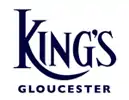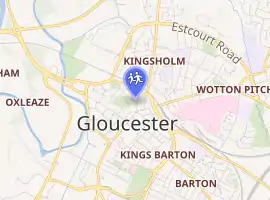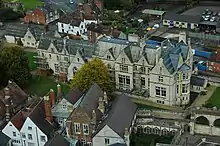King's School, Gloucester
The King's School, Gloucester is a co-educational independent day school in Gloucester, England. It traces its heritage to a school for choirboys founded in the grounds of Gloucester Cathedral as early as the 12th century and was one of seven 'King's Schools' established, or re-endowed and renamed by King Henry VIII in 1541 after the Dissolution of the Monasteries.
| The King's School, Gloucester | |
|---|---|
 | |
| Address | |

| |
, , GL1 2BG England | |
| Information | |
| Type | Public School Independent day school Cathedral school |
| Religious affiliation(s) | Church of England |
| Established | c.12th century 1541 |
| Local authority | Gloucestershire |
| Department for Education URN | 115780 Tables |
| Headmaster | David Morton |
| Gender | Co-educational |
| Age | 3 to 18 |
| Enrolment | 69 |
| Website | thekingsschool.co.uk |

History
The current school was officially founded in 1541 as a direct consequence of the English Reformation, by a direct royal proclamation of King Henry VIII.[1] However, there had been a school in the grounds of Gloucester Cathedral ever since it was first built as the Abbey of St. Peter around the year 1100.[2] Today the junior school still educates the choirboys and choirgirls of the cathedral.[3]
In 1540, during the dissolution of the monasteries, Henry VIII closed down the Abbey of St. Peter at Gloucester. In its place, by statutes of 1545, Henry established the cathedral and a school known as the "College School".[4] Henry VIII's statutes required the master of the school to be "skilful in Latin and Greek, of good fame, and a godly life, well qualified for teaching, who may train up in piety those children who shall resort to our school for grammar". In 1616 the controversial reformer William Laud was appointed Dean of Gloucester. As a result, the school became a victim of the religious disputes which led to the outbreak of the Civil War by 1642. Laud was executed during the war. In 1649, Parliament, following its victory in the Civil War, abolished Deans and Chapters. However, the school was considered too valuable a resource to be dispensed with.
After enduring a tumultuous time during the 17th century, the school experienced significant growth from the 18th century onwards. Under headmaster Maurice Wheeler, reforms were instituted throughout the school.[5] Cathedral choristers were fully integrated as pupils; previously they had been educated in separate classes. Physical education was introduced as a mandatory "subject". It was during his term that the school began to be referred to as "The King's School".
In the second half of the 19th century, the school went into decline, mainly due to financial difficulties, the rise of other public schools and the unwillingness of the Dean and Chapter to maintain more than a "music school". Through the efforts of then headmaster Francis Gillespy, funds were raised and the pupil roll gradually increased again. More buildings were bought and added to the campus and Archdeacon Meadow was upgraded.[6]
Buildings and facilities
The school is based around Pitt Street in the centre of Gloucester. It is near Gloucester Cathedral and has assemblies there every morning, which the whole school attends. Most public examinations are held in the Chapter House. The school is based in several buildings: The Palace, the Mathematics Centre, Little Cloister House (the oldest part of the school, containing the oldest continuously used classroom in the world,[8] Sixth Form Centre Dulverton House,[9] (the former residence of the Bishop of Tewkesbury), the Gym (formerly the main school building), the Art, Textiles and Design Technology department buildings, the Science block, the music school, Wardle House (the Nursery) and the Anniversary Building (Junior School).
The school is divided into three age groups:
- The Nursery, for 3-5 year olds
- Junior school, for ages 6–11
- Senior school, for ages 11–18
Pupils are divided into Houses; in the Senior School they are Laud, Wheeler and Serlo, named after, respectively, Archbishop William Laud, Maurice Wheeler, a former headmaster, and Abbot Serlo, an important figure in the founding of Gloucester Cathedral. There are House competitions all year round, including sports, music and quizzes.
Archdeacon Meadow
The school owns Archdeacon Meadow, which is used as a sports field for rugby and cricket for the boys, and rounders in the summer for the girls. House cross-country running is also usually held there. The Meadow was the home of the annual Gloucester Cricket Festival until it was scrapped in 2009.[10]
Notable former students
- Arthur Benoni Evans, a sermon-writer
- Button Gwinnett: mid 18th century; On behalf of Georgia signed the United States Declaration of Independence. With the outbreak of the American Revolutionary War, he became the President and Commander-in-chief of the U.S. state of Georgia. He died shortly afterwards when he somewhat foolishly challenged one of his political enemies to a duel, the injuries resulted in his death a few days later. Incidentally his autograph is one of the most valuable in the World due to its rarity.[11]
- John Stafford Smith: late 18th century; wrote the tune for "To Anacreon in Heaven". In 1814 Francis Scott Key would set his poem to this piece and was named Star Spangled Banner, the National Anthem of the United States.[11]
- Ivor Gurney: A 20th-century composer and poet; famous for poetry volumes Severn and Somme (1917) and War's Embers (1919), and well known songs such as Sleep. He makes direct references to the King's school in his poem Day-boys and Choristers (1919).[11]
- F. W. Harvey: 'The Laureate of Gloucestershire' a 20th-century English poet, known for poems composed in prisoner-of-war camps that were sent back to England during World War I. While at the King's school together Gurney and Harvey formed a close friendship, later in his life Harvey claimed that it was at King's that 'he learned to love music and how to learn'.[11]
- William Hayes: 1708-1777: Chorister at Gloucester Cathedral and articled to William Hine (organist). Organist at Shrewsbury, Worcester and later Informator Choristarum at Magdalen College, Oxford. Professor of Music at Oxford University. Composer of The Passions (performed at various Three Choirs Festivals), concertos and Ode to Echo. Founder of the Holywell Music Room in Oxford. Father of Philip Hayes, composer.
- Simon Pegg: Attended the junior school. English actor, comedian, writer, film producer and director most famous for his work in Hot Fuzz, Shaun of the Dead and Star Trek. Born and lived in Brockworth for most of his childhood.[11]
- Andy Johns: British record producer most famous for his work with Led Zeppelin, The Rolling Stones, Jimi Hendrix, Van Halen, Joni Mitchell and Rod Stewart. Born in England, Johns moved to Los Angeles in the 1970s with his wife Anet. Johns died on 7 April 2012, after completing work on his final record, Sabyrtooth's "Laugh Until I Die."[11]
- George Sheringham: painter and theatre designer[11]
References
- "King's School (Gloucester)". HMC. Archived from the original on 27 August 2019. Retrieved 30 August 2020.
- "King's and the Cathedral". Archived from the original on 20 October 2012. Retrieved 20 May 2012.
- "Gloucester Cathedral and The King's School". Gloucester Cathedral. Archived from the original on 30 August 2020. Retrieved 30 August 2020.
- Keeler, Natalie. "Senior School Anniversaries: A Step Back in Time". Independent School Parent. Archived from the original on 13 June 2017. Retrieved 30 August 2020.
- "Library" (PDF). Gloucester Cathedral. Archived (PDF) from the original on 30 August 2020. Retrieved 30 August 2020.
- "History of the School". Archived from the original on 20 October 2012. Retrieved 20 May 2012.
- "Regulatory Compliance Inspection Report December 2018" (PDF). Independent Schools Inspectorate. Archived (PDF) from the original on 30 August 2020. Retrieved 30 August 2020.
- "Head of Philosophy, Religion and Ethics (PRE) - Full Time". Glos Jobs. Archived from the original on 30 August 2020. Retrieved 30 August 2020.
- "Dulverton House (King's School)". National Heritage List for England. Historic England. Archived from the original on 4 April 2019. Retrieved 30 August 2020.
- "Gloucester". Archived from the original on 15 July 2012. Retrieved 3 June 2009.
- Stilliard, Ed (2 January 2019). "All the famous faces and names from Gloucester King's School". Gloucestershire Live. Archived from the original on 3 January 2019. Retrieved 30 August 2020.
External links
| Wikimedia Commons has media related to King's School, Gloucester. |
- School Website
- History of the choristers of Gloucester Cathedral
- Profile on the ISC website
- ISI Inspection Reports